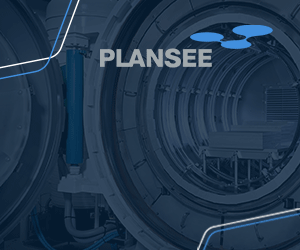Tungsten market looks to rebalance in 2017
February 17, 2017
Tungsten is one of the key refractory metals and this high melting point material has numerous applications, including incandescent light bulb filaments, X-ray tubes (as both the filament and target), electrodes in TIG welding, superalloys, and radiation shielding. Tungsten’s hardness and high density give it military applications in penetrating projectiles, and of course it is the key ingredient in tungsten carbide-based tools. Tungsten compounds are also often used as industrial catalysts.
Roskill Information Services Ltd, a London-based publisher of international metals and minerals market research reports, has published its assessment of the tungsten market in terms of supply, pricing, demand in key application areas and future outlook.
Roskill states that China has been the world’s largest consumer of tungsten for the past 20 years, increasing its share of world tungsten use from just under 30% in 1996 to nearly 60% in 2016 when world consumption of contained tungsten reached just over 100,000 tonnes. China is also still the world’s main producer of primary tungsten accounting for almost 80% of output in 2016.
However, the proportion of exports accounted for by the main intermediate, ammonium paratungstate (APT) powder products from China has decreased since 2008 along with exports of tungsten products such as oxide and metal powders. Instead, China has focused on increasing production and export of higher added value W products such as mixed metal carbides and cemented carbides.
Tungsten demand
In terms of end uses, cemented carbides remained the largest consuming sector in 2016 at more than 50% of total tungsten demand. This sector grew by more than 4% per annum between 2008 and 2016, mainly propelled by growth in production in China.
Recent trends in cemented carbides have included the development of nano-grained WC products showing both improved hardness and fracture toughness. At the other end of the spectrum extremely coarse grain tungsten carbide (WC) and cast WC grades have been successfully used in high-performance drilling tools for oil and gas exploitation, mining and road construction.
Applications for nano-sized hardmetals include micro tools, for example in drilling printed circuit boards (PCBs). Yet not all focus has been on nano-sized materials; for example, one challenge for raw material development is the design of WC powders suitable for use in Additive Manufacturing. AM using tungsten materials is still at an early stage, with the main challenges including the high melting points of W (3,422°C) and WC (2,870°C); plus the high cost and limited raw material availability.
Tungsten as an alloying element for steels and alloys continued to be the second largest end use for the metal in 2016, primarily in high speed steels and other tool steels.
In the mill products sector, consumption of tungsten is estimated to have peaked at over 15,000t contained W in 2012 but has been in decline since this time – primarily because of lower tungsten use in lamp filaments, as uptake of light emitting diodes (LEDs) has increased.
In the period to 2026, LED lamps are likely to gain a much larger share of the global market as phase-out of incandescent bulbs continues. LEDs could account for as much as 95% of the lighting market by 2026.
New tungsten supply
Roskill states that new mine developers have looked to offer a non-Chinese alternative to the tungsten concentrates market. A significant producer is Vietnam-based Nui Phao Mining Company, a subsidiary of Masan Resources, which began full commercial production in March 2014. Nui Phao produces tungsten, fluorspar, bismuth and copper, with output in 2016 estimated at 4,300t contained W. Tungsten output from the mine is sent to Nui Phao – H.C Starck Tungsten Chemicals Manufacturing, which began operations in 2015. Capacity of the plant is 6,500tpy WO3 and the facility can produce APT, tungsten blue oxide and tungsten yellow oxide.
Elsewhere in the world, Australian-headquartered Wolf Minerals commissioned the Drakelands tungsten-tin mine at Hemerdon in Devon, UK, in 2015. Nearly all mine output from Drakelands is exported; Wolf has offtake agreements with Global Tungsten & Powders of the USA and Wolfram Bergbau in Austria that account for 80% of mine output.
There are additionally tens of tungsten mine projects currently under development and in the period to 2026, Roskill expects that more than 10,000tpy (contained W) will be successfully brought online. Most projects are focused in Australia, Spain and Canada, and if all come to fruition then the landscape for primary tungsten supply could shift to much higher contributions from Oceania, North America and Europe.
The ‘Tungsten: Market Outlook to 2026’, 12th Edition, is available from Roskill Information Services Ltd,

















